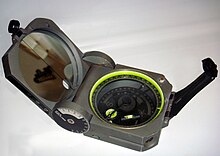Brunton compass
This articleneeds additional citations forverification.(January 2017) |

ABrunton compass,properly known as theBrunton Pocket Transit,is a precisioncompassmade byBrunton, Inc.ofRiverton, Wyoming.The instrument was patented in 1894 by Canadian-born geologist David W. Brunton.[1]Unlike most modern compasses, the Brunton Pocket Transit utilizesmagnetic induction dampingrather than fluid to damp needle oscillation. Although Brunton, Inc. makes many other types of magnetic compasses, the Brunton Pocket Transit is a specialized instrument used widely by those needing to make accurate navigational and slope-angle measurements in the field. Users are primarilygeologists,butarchaeologists,environmental engineers,mining engineersandsurveyorsalso make use of the Brunton's capabilities. TheUnited States Armyhas adopted the Pocket Transit as the M2 Compass for use by crew-servedartillery.
Overview
[edit]The Pocket Transit may be adjusted fordeclination angleaccording to one's location on the Earth. It is used to get directional degree measurements (azimuth) through use of theEarth's magnetic field.Holding the compass at waist-height, the user looks down into the mirror and lines up the target, needle, and guide line that is on the mirror. Once all three are lined up and the compass is level, the reading for that azimuth can be made. Arguably the most frequent use for the Brunton in the field is the calculation of thestrike and dipofgeologicalfeatures (faults,contacts,foliation,sedimentary strata,etc.). Strike is measured by leveling (with thebull's eye level) the compass along the plane being measured. Dip is taken by laying the side of the compass perpendicular to the strike measurement and rotating horizontal level until the bubble is stable and the reading has been made. If field conditions allow, additional features of the compass allow users to measure such geological attributes from a distance.
As with most traditional compasses, directional measurements are made in reference to theEarth's magnetic field.Thus, measurements are sensitive to magnetic interference. For example, if the user is near an outcrop that containsmagnetiteor some otheriron-bearing material, compass readings can be affected anywhere from several inches from theoutcropto tens of yards away (depending on the strength of the magnetic field). Since they are measured with a rotatinglevel,dip measurements are unaffected by magnetic interference.
Other compasses
[edit]There are numerous other compasses used by geologists: TheBreithaupt compassis one example. Portable electronic devices are changing the way geologists conduct field work. Unlike analogue compasses, a digital compass relies on an accelerometer and amagnetometer,and may provide information about the reliability of a measurement (e.g. by repeating the same measurement and performing statistical analysis).
Uses
[edit]- Taking a bearing
- Measuring vertical angles with clinometer
- Defining points of the same elevation
- Measuring strike and dip.[2]
References
[edit]- ^Hodgson, Michael,Compass and Map Navigator,Guilford, CT: The Globe Pequot Press, (1997) ISBN 0-7627-0488-0, p. 4
- ^Assaad, Fakhry A.; LaMoreaux, James W.; Hughes, Travis, eds. (2013).Field Methods for Geologists and Hydrogeologists.Springer Science & Business Media. pp. 38–39.ISBN978-3-662-05438-3.Retrieved10 June2015.
